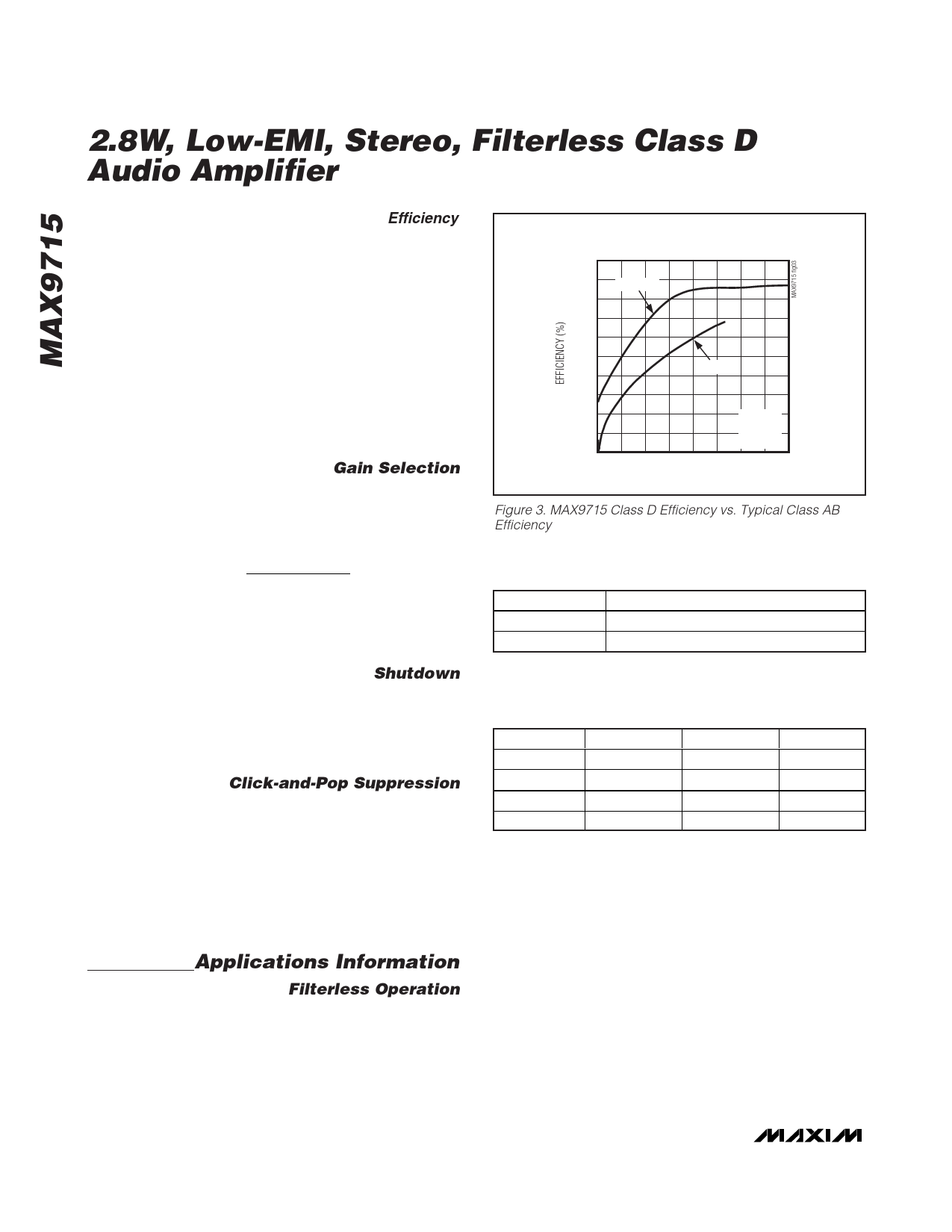MAX9715 View Datasheet(PDF) - Maxim Integrated
Part Name
Description
Manufacturer
MAX9715 Datasheet PDF : 13 Pages
| |||

2.8W, Low-EMI, Stereo, Filterless Class D
Audio Amplifier
Efficiency
Efficiency of a Class D amplifier is attributed to the region
of operation of the output-stage transistors. In a Class D
amplifier, the output transistors act as current-steering
switches and consume negligible additional power. Any
power loss associated with the Class D output stage is
mostly due to the I2R loss of the MOSFET on-resistance,
switching losses, and quiescent current overhead.
The theoretical best efficiency of a linear amplifier is
78%, however, that efficiency is only exhibited at peak
output powers. Under normal operating levels (typical
music or voice reproduction levels), efficiency falls
below 30%. Under the same conditions, the MAX9715
still exhibits >80% efficiencies (Figure 3).
Gain Selection
Drive GAIN high to set the gain of the speaker ampli-
fiers to +9dB, drive GAIN low to set the gain of the
speaker amplifiers to +10.5dB (see Table 1). The gain
of the MAX9715 is calculated by the following equation:
20
×
⎛
log ⎝⎜
VOUT+ − VOUT−
VIN
⎞
⎠⎟
Table 2 shows the speaker amplifier input voltage need-
ed to attain maximum output power from a given gain set-
ting and load.
Shutdown
The MAX9715 features a 0.1μA low-power shutdown
mode that reduces quiescent current consumption and
extends battery life. Driving SHDN low disables the out-
put amplifiers, bias circuitry, and drives BIAS to GND.
Connect SHDN to logic 1 for normal operation.
Click-and-Pop Suppression
The MAX9715 speaker amplifiers feature Maxim’s com-
prehensive, industry-leading click-and-pop suppression
that eliminates any audible transients at startup. The out-
puts are high-impedance while in shutdown. During
startup or power-up, the modulator bias voltage is set to
the correct level while the input amplifiers are muted. The
input amplifiers are muted for 25ms allowing the input
capacitors to charge to the bias voltage (VBIAS). The
amplifiers are then unmuted, ensuring click-free startup.
Applications Information
Filterless Operation
Traditional Class D amplifiers require an output filter to
recover the audio signal from the amplifier’s PWM output.
The filters add cost, increase the solution size of the
100
90
80
70
60
50
40
30
20
10
0
0
EFFICIENCY
vs. OUTPUT POWER
MAX9715
CLASS AB
VDD = 5V
RL = 8Ω
fIN = 1kHz
0.25 0.50 0.75 1.00 1.25 1.50 1.75 2.00
OUTPUT POWER (W)
Figure 3. MAX9715 Class D Efficiency vs. Typical Class AB
Efficiency
Table 1. MAX9715 Maximum Gain Settings
GAIN
0
1
SPEAKER MODE GAIN (dB)
+10.5
+9.0
Table 2. MAX9715 Input Voltage and Gain
Settings for Maximum Output Power
GAIN (dB)
10.5
9.0
10.5
9.0
INPUT (VRMS)
0.90
1.08
1.00
1.19
RL (Ω)
4
4
8
8
POUT (W)
2.3
2.3
1.4
1.4
amplifier, and can decrease efficiency. The traditional
PWM scheme uses large differential output swings (2 x
VDD(P-P)), which causes large ripple currents. Any para-
sitic resistance in the filter components results in a loss
of power, lowering the efficiency.
The MAX9715 does not require an output filter. The
device relies on the inherent inductance of the speaker
coil and the natural filtering of both the speaker and the
human ear to recover the audio component of the
square-wave output. The elimination of the output filter
results in a smaller, less costly, more efficient solution.
8 _______________________________________________________________________________________